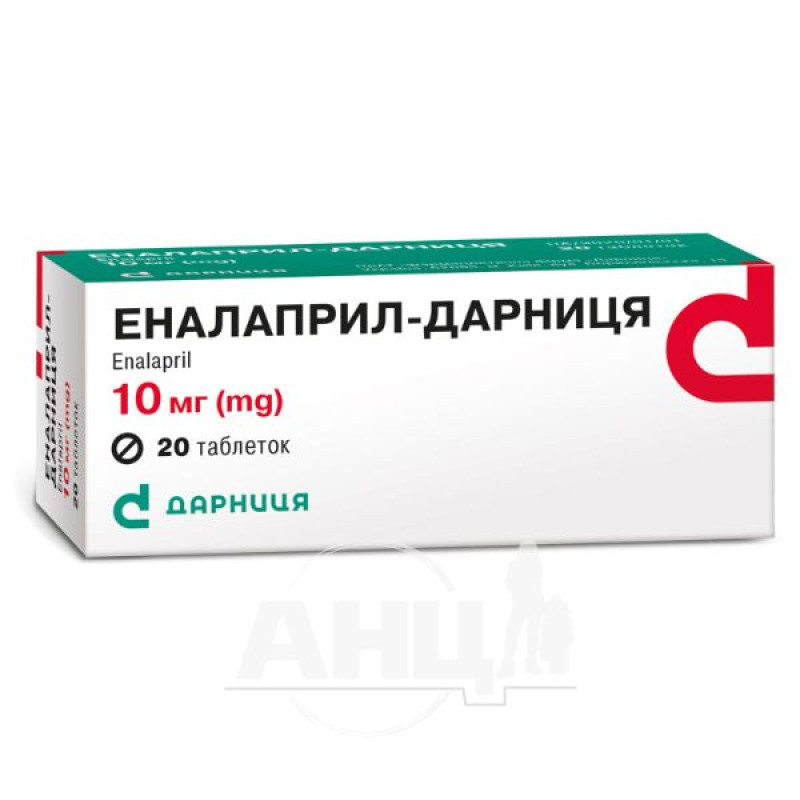Enalapril-Darnitsa tablets 10 mg No. 20

Enalapril-Darnitsa tablets are used for the following indications:
Treatment of arterial hypertension. Treatment of clinically significant heart failure. Prevention of clinically significant heart failure in patients with asymptomatic left ventricular dysfunction (ejection fraction ≤ 35%).Composition
Active ingredient: enalapril;
1 tablet contains enalapril maleate 10 mg;
Excipients: microcrystalline cellulose, potato starch, lactose monohydrate, calcium stearate.
Contraindication
Hypersensitivity to enalapril, to any of the excipients or to any other ACE inhibitor. History of angioedema associated with the use of ACE inhibitors. Hereditary or idiopathic angioedema. Enalapril should not be used with drugs containing aliskiren, in patients with diabetes mellitus or with impaired renal function (GFR <60 ml/min/1.73 m2). Pregnant women or women planning to become pregnant. Enalapril should not be taken within 36 hours of switching from/to sacubitril/valsartan, a drug containing a neprilysin inhibitor.Method of application
The tablets should be taken whole with a small amount of water, regardless of meals. Enalapril-Darnitsa should be taken at the same time every day and the recommended dose should not be exceeded.
A 10 mg tablet can be divided; if a 5 mg dose is prescribed, use ½ tablet.
In patients with a strongly activated angiotensin-aldosterone system (e.g. renovascular hypertension, salt and fluid imbalance, decompensated cardiac function or severe arterial hypertension), an excessive fall in blood pressure may occur after taking the initial dose. In such patients, a starting dose of 5 mg or lower is recommended, and the initiation of treatment should be under medical supervision.
Application features
Pregnant women
The drug should not be used by pregnant women or women planning to become pregnant.
Children
The drug is intended only for children with arterial hypertension, but is not recommended for use for other indications.
Enalapril-Darnitsa should be used in children over 6 years of age.
Due to lack of data, enalapril is not recommended for the treatment of children with glomerular filtration rate less than 30 ml/min/1.73 m2.
Drivers
It should be noted that dizziness or hypotension may occasionally occur, which may affect the reaction rate when driving or operating other mechanisms.
Overdose
Data on overdose in humans are limited.
Symptoms. The most likely manifestation of overdose is hypotension, which begins 6 hours after taking the tablets, in parallel with the blockade of the renin-angiotensin system and stupor. Symptoms characteristic of overdose include cardiovascular shock, electrolyte imbalance, renal failure, hyperventilation of the lungs, tachycardia, palpitations, bradycardia, dizziness, a feeling of fear, cough. Serum levels of enalapril exceed 100 and 200 times the levels observed after the use of therapeutic doses, after taking 300 mg and 440 mg of enalapril, respectively.
Treatment. It is recommended to carry out intravenous infusion of 0.9% sodium chloride solution. If arterial hypertension occurs, the patient should be placed in a horizontal position. If necessary, angiotensin II infusion and / or intravenous administration of catecholamines should be prescribed. If the intake was recent, measures should be taken to eliminate enalapril (vomiting, gastric lavage, administration of sorbents and sodium sulfate).
Enalapril can be removed from the systemic circulation by hemodialysis.
Side effects
From the organs of vision: blurred vision. From the organs of hearing and vestibular apparatus: tinnitus, vertigo. From the respiratory system, chest and mediastinal organs: cough, shortness of breath, rhinorrhea, pharyngitis, dysphonia, sore throat, hoarseness, bronchospasm / asthma, pulmonary infiltrate, rhinitis, allergic alveolitis / eosinophilic pneumonia. From the gastrointestinal tract: nausea, diarrhea, abdominal pain, taste changes, intestinal obstruction, pancreatitis, vomiting, dyspepsia, constipation, anorexia, gastric irritation, dry mouth, peptic ulcers, stomatitis / aphthous ulcers, glossitis, angioedema of the gastrointestinal tract. From the liver and biliary tract: hepatic failure; hepatitis - hepatocellular or cholestatic; hepatonecrosis; cholestasis, including jaundice. Renal and urinary disorders: renal dysfunction, renal failure, proteinuria, oliguria. Endocrine disorders: syndrome of inappropriate antidiuretic hormone secretion. Metabolism and metabolism: hypoglycemia. Nervous system disorders: headache, depression, dizziness, confusion, drowsiness, insomnia, nervousness, paresthesia, sleep disorders, sleep disturbances, abnormal dreams. Cardiovascular system disorders: hypotension (including orthostatic hypotension), syncope, chest pain, cardiac arrhythmias, angina pectoris, tachycardia, palpitations, myocardial infarction or cerebrovascular stroke (possibly secondary to excessive hypotension in high-risk patients), Raynaud's syndrome. Blood and lymphatic system disorders: Anemia (including aplastic and hemolytic), neutropenia, decreased hemoglobin, decreased hematocrit, thrombocytopenia, agranulocytosis, bone marrow depression, pancytopenia, lymphadenopathy, autoimmune diseases. Skin and subcutaneous tissue disorders: Rash, hypersensitivity/angioedema: Angioedema of the face, extremities, lips, tongue, glottis and/or larynx has been reported; increased sweating, pruritus, urticaria, alopecia, erythema multiforme, Stevens-Johnson syndrome, exfoliative dermatitis, toxic dermal necrolysis, pemphigus, erythroderma. A symptom complex has been reported, which may include the following symptoms: fever, serositis, vasculitis, myalgia/myositis, arthralgia/arthritis, positive antinuclear antibodies, increased erythrocyte sedimentation rate (ESR), eosinophilia, leukocytosis. Rash, photosensitivity or other dermatological manifestations may occur. Reproductive system and breast disorders: impotence, gynecomastia. General disorders: asthenia, fatigue, muscle spasms, muscle cramps, hot flashes, malaise, fever.Interaction
Alcohol enhances the hypotensive effect of ACE inhibitors.
Sympathomimetics may reduce the antihypertensive effects of ACE inhibitors.
Storage conditions
Store out of the reach of children in the original packaging at a temperature not exceeding 25 °C.
Shelf life - 2 years.
There are no reviews for this product.
There are no reviews for this product, be the first to leave your review.
No questions about this product, be the first and ask your question.



